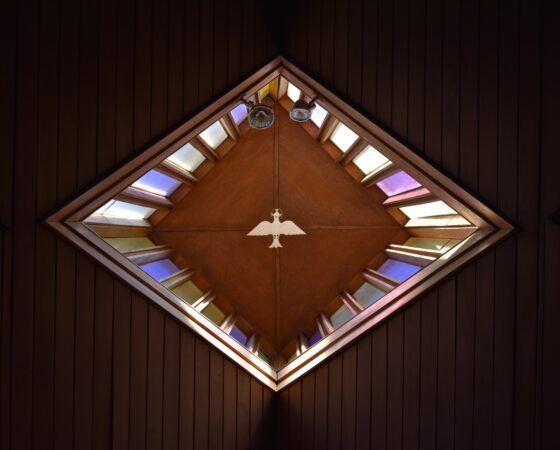Epiphany Two (Revised Common Lectionary) | 15.01.23 | John 1.29-42 | Carl A. Voges |
The Passage
The next day he (John) saw Jesus coming toward him and said, “Behold, the Lamb of God, who takes away the sin of the world! This is he of whom I said, ‘After me comes a man who ranks before me, because he was before me.’ I myself did not know him, but for this purpose I came baptizing with water, that he might be revealed to Israel.” And John bore witness: “I saw the Spirit descend from heaven like a dove, and it remained on him. I myself did not know him, but he who sent me to baptize with water said to me, ‘He on whom you see the Spirit descend and remain, this is he who baptizes with the Holy Spirit.’ And I have seen and have borne witness that this is the Son of God.”
The next day again John was standing with two of his disciples, and he looked at Jesus as he walked by and said, “Behold, the Lamb of God!” the two disciples heard him say this, and they followed Jesus. Jesus turned and saw them following and said to them, “What are you seeking?” And they said to him, “Rabbi” (which means Teacher), where are you staying?” He said to them, “Come and you will see.” So they came and saw where he was staying, and they stayed with him that day, for it was about the tenth hour.
One of the two who heard John speak and followed Jesus was Andrew, Simon Peter’s brother. He first found his own brother Simon and said to him, “We have found the Messiah” (which means Christ). He brought him to Jesus. Jesus looked at him and said, “So you are Simon the son of John? You shall be called Cephas” (which means Peter). [English Standard Version]
“…the grace of God that was given you in Christ Jesus, that in every way you were enriched in him in all speech and all knowledge…so that you are not lacking in any spiritual gift….“ [1 Corinthians 1.4-5, 7]
In the Name of Christ + Jesus our Lord
After being immersed in the Son’s Incarnation on 25 December, the Lord’s people made their way through the Twelve Days of Christ Mass, paying attention to the feasts of St. Stephen, St. John and the Holy Innocents, then turning into the Name and Circumcision of Jesus, and, nine days ago, exulting in his Epiphany on 06 January. This past Sunday we were brought into the Son’s Baptism. This morning, as we step more fully into the Epiphany season, we concentrate on what the LORD God has done and is doing through the Birth of his Son.
What is so striking about these ways is that they are glossed over or ignored by most of the people around us! This reality surfaced in conversations with a couple of acquaintances last week. One individual concluded that, after negative experiences in a Protestant church, it is much better to not be religious but to be spiritual! Another person, raised in the Roman Catholic Church, turned her back on it because, after a divorce and another marriage, it is only interested in her contributions!
While these perspectives make some sense, they create other realities because they can lead to holes and vacuums in their lives. This enables the world’s gods to swarm in and offer their “help” so individuals can manage such lives on their own! Such vacuums and holes are not always clearly seen, but they do surface, unleashing pathetic and tragic realities.
As much as we would like to, the Lord’s baptized people cannot just storm into such lives and create rescuing actions. Rather, we can be drawn more fully into his Life, the Life alone which has the ability to be mysteriously reflected to the lives of others. Consequently, it is instructive for us to be impacted by today’s Gospel. These verses from John’s first chapter, while complex, point us to the extraordinary depth and satisfaction of the Trinity’s Life as the Son’s Incarnation makes its way through this world. There are two sections in the passage.
In the first section John the Baptizer sees Jesus coming toward him and declares – Here is the Lamb of God who takes away the world’s sin! These familiar words are sung in the Liturgy just before we take part in the Lord’s Supper. Our Lord as a Lamb? If he is doing to do that, shouldn’t he be more like a lion? No, a Lamb! Jesus will take away the instinctive desire to be like the LORD God (which is the biblical definition of sin). He will destroy the death generated by such desire. For such work it is obvious we are not describing a soft, cuddly animal. Instead we’re describing an animal that is huge, flexing with muscle and strength.
Such a description is reinforced by the biblical background to the Lamb. First, in Jewish thought there is the Lamb for the End-of-Time (that Lamb is described as the conqueror who destroys the evil in the world). Such a description is also seen in numerous references in John the Evangelist’s book of Revelation. Recall, too, that John the Baptizer warned of the Lord’s wrath bearing down on the world (clearly the biblical background is not dealing with soft or cuddly images!).
Second, there is the Lamb as a suffering Servant. The background for this description is seen in Isaiah, especially in his four Servant-Songs (last Sunday we heard the first Song, Isaiah 42, in the First Lesson; today we hear the second one, Isaiah 49, also the First Lesson).
Third, there is the Lamb as the Paschal Lamb. The background for this understanding is seen in the Passover Meal, the annual observance of Israel’s rescue from its slavery in Egypt. This last understanding, with overtones of the suffering Servant, runs throughout John’s Gospel. The Lamb takes away the world’s sin by his death. According to John’s Gospel, Jesus was condemned to death at noon on the day before the Passover. This was the identical time when the priests were beginning to kill the Passover lambs in the temple.
Further, while Jesus was still on the cross, a sponge full of wine was raised up to him on a stick (hyssop). It was a hyssop that was smeared with the blood of the Passover lamb applied to the door frames of the Israelites in Egypt. Finally, none of Jesus’ bones were
broken (recall that there were no broken bones in the lambs being killed for the Passover
Meal). All of this is in the background when John the Baptizer declares that Jesus is the Lamb of God!
In the Gospel’s second section, Jesus notices two of John’s disciples following him and he asks what they want. They are looking, they want to know where he lives. This matter of where Jesus lives is a word that is used a great deal in John’s Gospel. It is the same word that describes Jesus’ relationship in and with his Father. Later on in the Gospel we see that Jesus’ followers are pulled into that same relationship (this is incredible picture!). That’s why when these two want to know where Jesus lives, he invites them to come and see. They go and see, and they stay!
The mention of the tenth hour (4 pm) suggests that it was the afternoon before the Passover was to begin. This means that those two disciples had to stay with Jesus until Saturday evening. They could not do any traveling from 6 pm on Friday to 6 pm on Saturday.
The result of such seeing and staying is that one of the disciples, Andrew, reports to his brother, Simon, that they have found the Messiah! Jesus, in turn, looks at Simon (a penetrating look, one boring into him) and changes his name. Peter no longer belongs to the world into which he was born, he now belongs to the LORD God!
John’s Gospel reveals clearly that eternal Life is promised to those who come to Jesus, who look on him, who believe in him. This passage then, while complex, demonstrates clearly that the looking pursued by the world’s people for a full life is best satisfied when the looking is to the Lord Jesus Christ rather than to the gods of their making and maintaining.
This returns us, then, to the vacuums and holes we create for ourselves when we stride out to make something of our lives by utilizing the world’s gods. Walking away from the Father, Son and Holy Spirit is not the best decision for the world’s people. Yet that is how we are inclined. Whether we are aware of that inclination or not, there is a pressing need to be rescued from it. Recall that in Psalm 2 the LORD God laughs at the world’s gods and derides them! Further, in Psalm 4 he asks how long will we dishonor his glory by worshiping dumb idols and running after false gods?
The overwhelming reality (whether recognized or not) is that it is the Lord’s Life which brought this world and its people into being and keeps it going. As we move more deeply into this Epiphany season we will find out what the Lord is doing as the Son’s Incarnation slowly, yet powerfully, pushes into the world’s life. Thoroughly immersed in the Lord’s Scriptures and his Sacraments of Baptism, Forgiveness and Eucharist, we are baptized and ordained to be faithful and mysterious reflectors of the Lord’s saving and sustaining activity in all we are and do.
When it comes to comparing what we and everyone else look for in the world’s gods and what we look for in the LORD God, there is no real comparison. While the majority of
people in this world are not aware of it yet, they are looking for the Lamb of God who
takes away the world’s sin! Their lives are pressed down by the realities of such sin. Their lives are weighed down by it, it is tearing their lives apart, it is wreaking havoc in their relationships with others and in their relationship with the LORD God. Sin is what keeps us steadily committed to the gods of our making and it is sin exhausting us from all their maintenance.
The great, good news today, then, is that, after hundreds of years of promises, the Father, the Son and the Holy Spirit are slipping their Life into this world, saving its people from their instincts to do everything their own way!
Now may the peace of the LORD God, which is beyond all understanding, keep our
hearts and minds through Christ + Jesus Our Lord
Pr. Carl A. Voges, STS, Columbia, SC; carl.voges4@icloud.com

